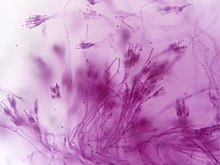Penicillium
This article may be too technical for most readers to understand. (August 2018) |
| Penicillium | |
|---|---|

| |
| Penicillium sp. | |
| Scientific classification | |
| Domain: | Eukaryota |
| Kingdom: | Fungi |
| Division: | Ascomycota |
| Class: | Eurotiomycetes |
| Order: | Eurotiales |
| Family: | Aspergillaceae |
| Genus: | Penicillium Link (1809) |
| Type species | |
| Penicillium expansum Link (1809)
| |
| Species | |
| Synonyms[1] | |
|
List
| |
Penicillium (/ˌpɛnɪˈsɪliəm/) is a genus of ascomycetous fungi that is part of the mycobiome of many species and is of major importance in the natural environment, in food spoilage, and in food and drug production.
Some members of the genus produce penicillin, a molecule that is used as an antibiotic, which kills or stops the growth of certain kinds of bacteria. Other species are used in cheesemaking. According to the Dictionary of the Fungi (10th edition, 2008), the widespread genus contains over 300 species.[2]
Taxonomy
The genus was first described in the scientific literature by
In his 1979
Species

Selected species include;
- Penicillium albocoremium
- Penicillium aurantiogriseum, a grain contaminant
- Penicillium bilaiae, which is an agricultural inoculant
- Penicillium candidum, which is used in making Brie and Camembert. It has been reduced to synonymy with Penicillium camemberti
- Penicillium notatum), which produces the antibiotic penicillin
- Penicillium claviforme
- Penicillium commune
- Penicillium crustosum
- Penicillium digitatum, a Citrus pathogen
- Penicillium echinulatum produces Mycophenolic acid
- Penicillium expansum, a pathogen of apples and other fruit, produces patulin
- Penicillium glabrum
- Penicillium imranianum
- Penicillium italicum, a Citrus pathogen
- Penicillium lacussarmientei
- Penicillium lusitanum, isolated from marine habitat
- Penicillium purpurogenum
- Gorgonzola cheese, and Cambozola
- Penicillium stoloniferum
- Penicillium ulaiense, a Citrus pathogen in Asia
- Penicillium verrucosum, a grain contaminant which produces ochratoxin A
- Penicillium viridicatum
Etymology
The genus name is derived from the Latin root penicillum, meaning "painter's brush", and refers to the chains of conidia that resemble a broom.[7]
Characteristics

The
Sexual reproduction involves the production of
Ecology
Species of Penicillium are ubiquitous soil fungi preferring cool and moderate climates, commonly present wherever organic material is available.
Some Penicillium species affect the fruits and bulbs of plants, including
Penicillium species are present in the air and dust of indoor environments, such as homes and public buildings. The fungus can be readily transported from the outdoors, and grow indoors using building material or accumulated soil to obtain nutrients for growth. Penicillium growth can still occur indoors even if the relative humidity is low, as long as there is sufficient moisture available on a given surface. A British study determined that Aspergillus- and Penicillium-type spores were the most prevalent in the indoor air of residential properties, and exceeded outdoor levels.
Some Penicillium species cause damage to machinery and the combustible materials and lubricants used to run and maintain them. For example,
Economic value
Several species of the genus Penicillium play a central role in the production of cheese and of various meat products. To be specific, Penicillium molds are found in blue cheese. Penicillium camemberti and Penicillium roqueforti are the molds on Camembert, Brie, Roquefort, and many other cheeses. Penicillium nalgiovense is used in soft mold-ripened cheeses, such as Nalžovy (ellischau) cheese, and to improve the taste of sausages and hams, and to prevent colonization by other molds and bacteria.[17][18]
In addition to their importance in the food industry, species of Penicillium and Aspergillus serve in the production of a number of biotechnologically produced enzymes and other macromolecules, such as gluconic, citric, and tartaric acids, as well as several pectinases, lipase, amylases, cellulases, and proteases. Some Penicillium species have shown potential for use in bioremediation, more specifically mycoremediation, because of their ability to break down a variety of xenobiotic compounds.[19]
The genus includes a wide variety of species molds that are the source molds of major
Reproduction
Although many eukaryotes are able to reproduce sexually, as much as 20% of fungal species had been thought to reproduce exclusively by asexual means. However recent studies have revealed that sex occurs even in some of the supposedly asexual species. For example, sexual capability was recently shown for the fungus Penicillium roqueforti, used as a starter for blue cheese production.[25] This finding was based, in part, on evidence for functional mating type (MAT) genes that are involved in fungal sexual compatibility, and the presence in the sequenced genome of most of the important genes known to be involved in meiosis. Penicillium chrysogenum is of major medical and historical importance as the original and present-day industrial source of the antibiotic penicillin. The species was considered asexual for more than 100 years despite concerted efforts to induce sexual reproduction. However, in 2013, Bohm et al.[26] finally demonstrated sexual reproduction in P. chrysogenum.
These findings with Penicillium species are consistent with accumulating evidence from studies of other eukaryotic species that sex was likely present in the common ancestor of all eukaryotes.[27] Furthermore, these recent results suggest that sex can be maintained even when very little genetic variability is produced.
Prior to 2013, when the "one fungus, one name" nomenclature change came into effect, Penicillium was used as the genus for anamorph (clonal forms) of fungi and Talaromyces was used for the teleomorph (sexual forms) of fungi. After 2013 however, fungi were reclassified based on their genetic relatedness to each other and now the genera Penicillium and Talaromyces both contain some species capable of only clonal reproduction and others that can reproduce sexually.
References
- Westerdijk Fungal Biodiversity Institute. Retrieved 2023-09-20.
- ISBN 978-0-85199-826-8.
- ^ Identification and nomenclature of the genus Penicillium, C.M. Visagie1, J. Houbraken1, , , J.C. Frisvad2, , , S.-B. Hong3, C.H.W. Klaassen4, G. Perrone5, K.A. Seifert6, J. Varga7, T. Yaguchi8, R.A. Samson, 22 September 2014, https://dx.doi.org/10.1016/j.simyco.2014.09.001
- ^ Link, JHF (1809). "Observationes in ordines plantarum naturales. Dissertatio I". Magazin der Gesellschaft Naturforschenden Freunde Berlin (in Latin). 3: 3–42.
- ISBN 978-0-306-42222-5.
- ISBN 978-0-12-557750-2.
- ISBN 978-1-930513-49-5. Retrieved 2013-02-03.
- )
- ^ Samson RA, Seifert KA, Kuijpers AF, Houbraken JA, Frisvad JC (2004). "Phylogenetic analysis of Penicillium subgenus Pencillium using partial beta-tubulin sequences" (PDF). Studies in Mycology. 49: 175–200. Archived from the original (PDF) on 2012-03-22. Retrieved 2011-07-14.
- PMID 11204163.
- ISBN 978-1-85573-449-4. Retrieved 2013-02-03.
- hdl:11336/147639.
- S2CID 221867835.
- PMID 21243933.
- .
- ISBN 978-90-6764-388-7.
- PMID 26251231.
- ISBN 978-0-9824267-1-5. Retrieved 2013-02-03.
- PMID 19440525.
- ISBN 978-0-12-369353-2. Retrieved 2013-02-03.
- S2CID 111334.
- PMID 3277037.
- PMID 19468317.
- ^ S2CID 86101370.
- PMID 23185400.
- PMID 23307807.
- PMID 18663385.
- Harshberger, J. W. (1917). A Text-Book of Mycology and Plant Pathology. London: Churchill Livinstone. OCLC 879097707.
External links
- Asan, A. (2004). "Aspergillus, Penicillium, and Related Species Reported from Turkey" (PDF). Mycotaxon. 89 (1): 155–7.
- Samson, R.A.; Pitt, J.I. (2000). Integration of Modern Taxonomic Methods For Penicillium and Aspergillus Classification. CRC Press. p. 66. ISBN 978-9058231598.


